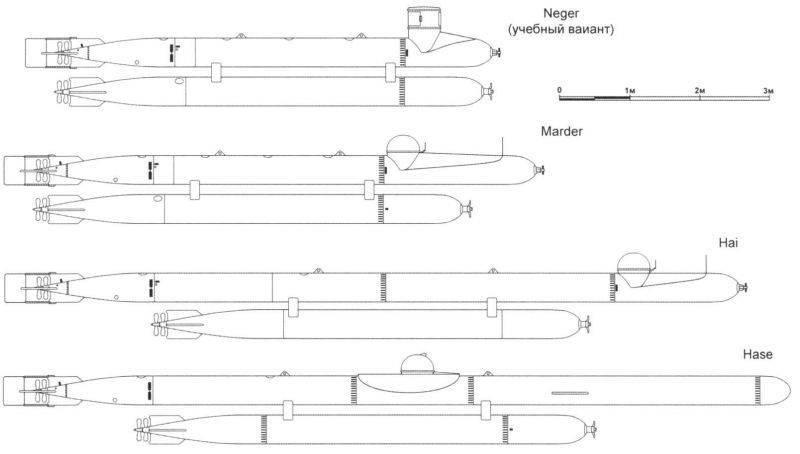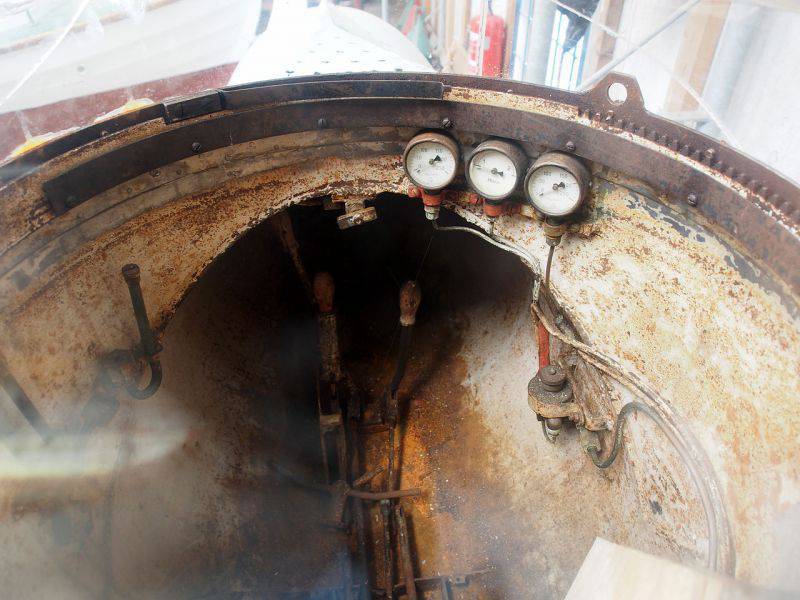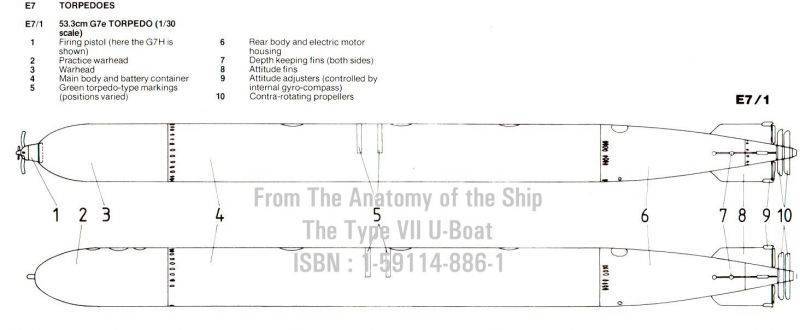Man-controlled torpedo Hai (Germany)
Nevertheless, the German armed forces and industry tried to find a way out of this situation. Until the very end of the war in Europe, the Germans hoped to increase the combat capability of the special Kleinkampfverbande compound with the help of new technology. To replace the available "Negera" and "Marderam" was to come human-controlled torpedo Hai ("Shark"). The development of this manned vehicle started in the winter of the year 1945, a few months before the signing of the surrender act.
All German human-controlled torpedoes, from Neger to Hai, were a gradual development of the same ideas, implemented on the basis of a single design. The basis for the first Neger was the serial torpedo G7e, which lost parts of the units and received a set of new special equipment. The next torpedo Marder was equipped with some new units. In the same way, it was planned to create the apparatus Hai. The main objectives of the new project were to increase the speed and range of navigation, which allowed, to a certain extent, to increase the combat potential of the vehicle. At the same time, however, it was necessary to use the maximum possible number of existing parts and assemblies.
Being a direct continuation of previous projects, the torpedo Hai had a mature architecture. In combat status, the unit consisted of two parts. In the upper cylindrical elongated body located cockpit, batteries, motor and control systems. On the bottom of the upper hull there were attachments for installing the G7e combat torpedo. It was assumed that the Hai vehicle, like its predecessors, would arrive in the target area and launch a torpedo.
The command of the Kleinkampfverbande compound was not fully satisfied with the characteristics of the existing human-guided torpedoes. For example, the unit "Marder" at an economic speed of about 4,2 node could go no more than 35 nautical miles. To participate in the upcoming raids, a torpedo with a greater range of travel and, accordingly, an increased radius of action in the context of a real operation was required. Thus, it was necessary to create an updated power plant and auxiliary units.
The new torpedo should have been built at the same enterprises as the previous ones. It was also required to achieve the maximum possible degree of unification in order not to re-adjust production. The authors of the project managed to find an original and easy way out. The hull of a torpedo Hai offered to assemble products from the Marder units. At the same time, to meet the basic requirements, the total length of the torpedo was increased.
Combat torpedoes G7e and Marder guided vehicles structurally consisted of three main compartments: the nose, center and tail. During assembly, all these units docked with each other. To lengthen the hull without any particular difficulties, the Shark project provided for the use of two central compartments installed one after another. In this way, German designers were able to significantly increase the overall dimensions and internal volumes of a torpedo without the need for a major change in production technologies.
The overall layout of the internal hull volumes of the Marder and Hai torpedoes was similar, considering the use of two central sections on the latter. A ballast tank for diving was located in the forward part, behind it was the driver’s cabin. Both central compartments contained in themselves rechargeable batteries. Due to the use of two sets of batteries, it was possible to increase the driving characteristics of the torpedo accordingly.
In the stern compartment of the apparatus housed an electric motor. In order to maintain the required travel speed, the torpedo Hai received a new 13 kW motor. For comparison, Neger and Marder were equipped with a 8,8-kilowatt engine. Behind the propeller, there were rudders to control the depth and direction.
The Shark received a nasal compartment, borrowed from Marder without any changes. A ballast tank with a volume of 30 l was located inside the nose fairing. Behind the cockpit there was a can of compressed air needed to purge the tank. The cylinder has not undergone any changes; its capacity, according to calculations, allowed 20 to float to the surface once.
As far as we know, the driver’s cab was borrowed from the existing torpedo without change. It had a seat, a set of controls and instruments to monitor the work of various systems. The driver could control the operation of the electric motor, control the direction of movement in two planes, and, if necessary, dive using a ballast tank. During the attack, the driver had to start the engine of the battle torpedo and press on the release lever.
Once again, a plexiglass dome of a shape close to a hemisphere was used to protect the driver. Mounts and locks allowed to quickly open it and leave the torpedo. The connection of the dome with the body of the torpedo was sealed with rubber seals to avoid water ingress.
Torpedo Hai was equipped with a life support system, developed during the operation of "Marder". Behind the driver’s seat, an oxygen bottle was provided with a gas supply required for several hours of operation. Oxygen under a small pressure was fed into the cabin and allowed a person to work both on the surface and at a shallow depth. In the event of a breakdown of the main life support system in the cockpit, there was a closed type breathing apparatus of the Dräger system.
Due to the use of two central sections, the length of the human-guided torpedo Hai was 11 m. The diameter of the hull did not change and was 533 mm. Taking into account the transparent dome, the overall height of the manned vehicle reached 1. In combat status, with the G7e torpedo suspended, the Shark weighed more than 5,2 tons.
To reach the area of the attack, it was intended to use only the own electric motor of the controlled unit. The 13-kilowatt engine before the combat torpedo discharge allowed a speed of no more than 4,5-5 knots. After executing the attack, the maximum stroke speed reached 5,5-6 nodes. It was possible to dive to a depth of 20-25 m in order to avoid detection by the enemy. Of particular note is the result of using a double set of batteries. Due to the introduction of the second section with batteries, it was possible to bring the estimated cruising range to 90 nautical miles (at an economic speed of around the 2,5 node). According to others, the Hai torpedo could accelerate to 20 nodes, and the maximum cruising range was 63 miles.
Attacking enemy ships was suggested in the same way. weaponsas before. To the bottom of the machine Hai torpedo G7e was attached. A product weighing more than 1600 kg was equipped with an 280-kg warhead. In the case of a torpedo there were batteries and an electric motor. Depending on the modification, the torpedo G7e could reach speeds up to 30 nodes and go up to 7000-7500 m. The characteristics of such weapons made it possible to attack enemy ships with a displacement of up to several thousand tons with high efficiency.
Being a further development of existing vehicles, torpedo "Shark" retained their method of application. Being launched, such a device was supposed to arrive in the target area. After that, the pilot should build an approach to the target, turn on the engine of the combat torpedo and make it uncouple. Then the saboteur could return to the starting place or go to the evacuation point. The presence of an oxygen cylinder made it possible to float for quite a long time, and the ballast tank made it possible to hide from the enemy under water without risking to detect itself and undergo an attack.
Hai project development ended in February 1945. Shortly thereafter, the assembly of experienced torpedoes began, which were to participate in the trials. According to various sources, no more than two devices were built, which soon went to one of the Kleinkampfverbande bases. The tests left a dual impression. On the one hand, the new torpedo had an increased cruising range, which significantly increased its combat potential. On the other hand, an increase in the length of the body affected a number of characteristics. Due to the additional section, maneuverability, stability and other parameters have deteriorated.
Probably, the Hai human-controlled torpedo could have gone into a series, but the success of the anti-Hitler coalition thwarted all such plans. According to some reports, the Shark's tests continued until May 8 of 1945. A few hours before the capitulation was signed, the responsible persons decided to destroy the prototypes so that they would not become the enemy's trophies. The loss of experienced torpedoes and the end of the war did not allow Germany to start mass production of new equipment and begin its use in battle.
The last German human-controlled torpedo did not have time to go to war. All existing samples were destroyed a few hours before the surrender. Therefore, it remains only to wonder how such devices could show themselves in full operation. Nevertheless, there is every reason to believe that the Hai torpedoes could hardly have had a noticeable impact on the course of the war at sea.
It is known that torpedoes Neger and Marder did not differ in high efficiency. From spring to autumn 1944, they sank and damaged no more than two dozen enemy ships. At the same time, no less than 200 was lost from the 120 of the built-in Negerov, and up to a hundred from the 300 of the Marders. The reason for the smaller losses among the devices Marder can be considered the opportunity to dive under the water and a more advanced life support system. Hai torpedoes had the same features, which made it possible to rely on the approximate preservation of combat effectiveness. However, in the case of the Shark, one should also consider the deterioration of maneuverability and seaworthiness, which could adversely affect the overall efficiency.
As a result, we can assume that the main difference between Hai torpedoes from the previous equipment of this class would be an increased radius of action. All other characteristics should have remained at the same level. This means that the Kleinkampfverbande connection, arranging new raids, would continue to lose equipment and people. Thus, even in case of successful completion, the Hai project could hardly bring Germany real benefits.
On the materials of the sites:
http://uboat.net/
http://bratishka.ru/
http://uboataces.com/
http://modelist-konstruktor.com/




Information